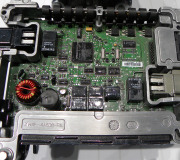For my first comment of value, from the TPS, the Engine Computer knows when you're at idle, when you're at wide-open-throttle, direction of throttle change, and rate of throttle change, in addition to throttle position. A common misconception is the computer sets the engine speed in response to the signal voltage it sees from the TPS. This description doesn't apply to newer cars with the insane and dangerous "throttle-by-wire" that put Toyota in the news a few years ago. On normal engines, throttle position is set by the cable connected to the accelerator pedal. As the throttle opens more, additional air enters the engine. On almost all engines except for Chrysler products, that air goes through a mass air flow sensor that measures the weight of that air. THAT is the main fuel metering sensor. The computer commands the appropriate amount of fuel to go with that air. The amount of fuel is just tweaked a little based on other sensor readings.
In this application, the TPS is used more to verify proper operation of the system, not control it. For example, if the engine is running at 2,500 rpm on the highway, the throttle position sensor had better not be reporting near 0.5 or 4.5 volts. At half-throttle, the signal voltage will be near 2.5 volts.
A common, but unknown use of the throttle position sensor's signal voltage is for the automatic transmission's lock-up torque converter. Chrysler invented that for the '77 models, but those were totally hydraulically-controlled inside the transmission. The torque converter, to keep it as simple as possible, is a fan spun by the engine, fluid that is spun by that fan, and another fan that is spun by that spinning fluid. The entire works is placed inside a metal housing that looks like a 15" diameter donut. There is always some slippage between those two fans. That is what allows the engine to idle at 800 rpm while the transmission and car do not move while standing still, in gear, at a top sign.
That slippage occurs less at highway speeds, but it does still occur, and that results in lower fuel mileage compared to a car with a manual transmission. The lock-up clutch mechanically locks the two fans in the torque converter together to improve fuel mileage, but that can't be allowed to occur at lower speeds or especially when you come to a stop. If it didn't release, it would be the same as forgetting to push the clutch pedal on a manual transmission when you came to a stop. It would snub the engine.
A number of things cause the lock-up clutch to unlock. While the first ones were all hydraulically-controlled inside the transmission, since the mid '80s, they are still applied with fluid pressure, but the flow of that fluid is controlled electrically, and that is handled by the Engine Computer and / or Transmission Computer. The required conditions that must be met are the engine must be warmed up, the transmission must be in the highest gear, or sometimes third or fourth with a four-speed automatic, and road speed must be above approximately 35 mph.
The whole point of this wondrous story is what it takes to make this clutch unlock. It does that below 35 mph to avoid a jerking or surging sensation, and it unlocks above roughly 3/4 throttle because in the normal "open" condition, a torque converter doubles torque compared to a manual transmission, and that improves your ability to pass that freight train of cars, or make it up a steep hill. It will also unlock anytime you press the brake pedal. The computer thinks you may be preparing to come to a stop. So it unlocks the clutch to be ready for that.
If you have a tachometer in your instrument cluster, you'll see engine speed drop 200 rpm when the lock-up clutch engages. An easy way to verify it's working is to hold the accelerator pedal perfectly steady at highway speed, then briefly tap the brake pedal with your left foot. You should see engine speed pick up 200 rpm, then drop back down a couple of seconds later.
The point of sharing this exciting information is because throttle position is one of the things that determines if the torque converter unlocks. If a customer complains of engine speed bouncing up and down while driving, the mechanic will connect a scanner to view live data, then he will watch what happens to the TPS readings when the symptom occurs. If a chip of carbon breaks off the sensing element, it could get stuck under the movable contact and lift it off the element. That would create an open circuit, just like if the signal wire was broken. The pull-up resistor would put 5.0 volts on the circuit. On some cars that needs to occur for a specific amount of time before a fault code will be set, but even if that doesn't happen, the momentary high voltage can be interpreted as wide-open-throttle. That will cause the torque converter to unlock. In fact, a dirty throttle position sensor and a misadjusted brake light switch are the two most common causes of a torque converter clutch unlocking intermittently. If you don't have a fault code related to the TPS circuit, and none of the symptoms I described are occurring, you likely don't have a problem with that sensor or its wiring.
The only thing you can do yourself for erratic idle speed is to check for vacuum leaks. If any air sneaks in that doesn't go through the mass air flow sensor, it won't be measured and it won't be included in the fuel metering calculations. The leak will cause engine speed to increase without a corresponding increase in power. The computer will try to correct engine speed, and that can affect how much air gets in through the leak.
Once a vacuum leak is eliminated as the cause of erratic idle speed, you need a scanner to see what the Engine Computer is responding to. That will tell the mechanic whether the computer is trying to reduce idle speed, without success, or it is trying to increase speed in response to some perceived need to do so. Engine speed is increased when coolant temperature is low. While coolant temperature sensors have an extremely low failure rate, Ford had the notable exception in the early '90s. Those did cause erratic idle speed. For other cars, corroded sensor terminals would be a better suspect. They don't cause signal voltage to go high enough to set a fault code, but the varying resistance makes the computer think the engine is still cold, and needs a higher idle speed.
Hopefully that will give you some direction in pursuing this problem. One place that is often overlooked when searching for vacuum leaks is the fresh air tube between the mass air sensor and the throttle body. There must be no cracks in the tube, loose hose clamps, or other leaks.
Friday, December 30th, 2016 AT 3:40 PM



